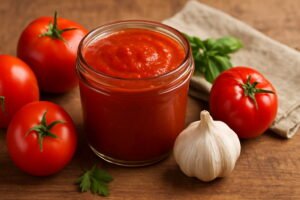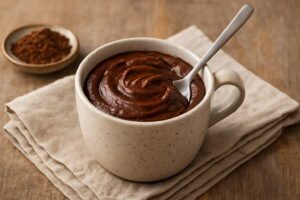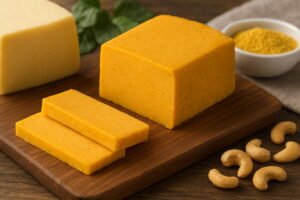Creating delicious gluten-free dishes can feel challenging, especially when trying to achieve the right texture, structure, and overall consistency. This is where tapioca starch becomes a true game-changer. In the world of gluten-free recipes, tapioca starch offers an impressive combination of versatility, functionality, and culinary reliability. Derived from the cassava root, this naturally gluten-free ingredient has become a staple for home cooks, food developers, and recipe creators who want to replicate the softness, elasticity, and lightness that gluten typically provides.
In this article, we’ll explore the benefits of tapioca starch in gluten-free recipes, breaking down how it works, what makes it unique, and why it should be considered a must-have in any gluten-free kitchen. Whether you bake regularly or simply want to upgrade your cooking results, understanding the role of tapioca starch will instantly improve the way you approach gluten-free dishes.
In This Article
What Makes Tapioca Starch Unique?
Tapioca starch stands out from other starches because of its clean, neutral flavor profile and its remarkable textural benefits. It is extracted by washing, pulping, and drying the fibrous cassava root, resulting in a fine white powder that blends seamlessly into both sweet and savory recipes.
Here’s what sets it apart:
Key Characteristics
- High carbohydrate content for efficient thickening
- Low allergen profile—naturally grain-free, nut-free, and gluten-free
- Smooth, silky texture that integrates effortlessly into batters and doughs
- Stable performance under freezing, thawing, and reheating
Comparison Table: Tapioca vs. Other Common Gluten-Free Starches
| Starch Type | Texture Contribution | Thickening Quality | Flavor Profile | Best Uses |
| Tapioca Starch | Soft, chewy, elastic | Clear, glossy | Neutral | Breads, sauces, frying |
| Arrowroot | Smooth, light | Clear but lighter | Neutral | Sauces, fruit fillings |
| Potato Starch | Light, fluffy | Opaque, strong | Mild | Breads, cakes |
| Cornstarch | Slightly firm | Cloudy, dense | Neutral | Gravies, stews |
Many gluten-free bakers describe tapioca as “the secret weapon” because it enhances texture without weighing recipes down. Its elasticity is unmatched among plant-based starches, making it particularly useful for baked goods where chewiness or stretch is desired.
A pastry chef once shared:
“If I could only choose one starch for gluten-free baking, it would be tapioca—nothing else delivers that perfect balance of softness and structure.”
The Essential Benefits of Tapioca Starch in Gluten-Free Recipes
When working with gluten-free ingredients, the biggest hurdles are usually dryness, crumbling, and density. Tapioca starch helps solve these issues by offering multiple functional benefits that mimic some of gluten’s natural qualities.
Core Benefits at a Glance
- Enhances texture, creating softness, chewiness, or crispiness as needed
- Acts as an effective binder, helping ingredients hold together
- Adds lightness and airiness to dense gluten-free flours
- Improves moisture retention, preventing baked goods from drying out
- Thickens sauces and fillings with a clear, glossy finish
- Has a neutral flavor, allowing other ingredients to shine
- Fits easily into paleo, AIP, vegan, and gluten-free diets
Case Study: Gluten-Free Bread Before & After Using Tapioca Starch
| Criteria | Without Tapioca | With Tapioca |
| Texture | Dense, crumbly | Soft, springy |
| Moisture | Dries quickly | Stays moist longer |
| Crust | Hard, brittle | Crisp yet flexible |
| Sliceability | Falls apart | Holds together well |
This versatility makes tapioca starch one of the most reliable and multifunctional ingredients when crafting gluten-free recipes that taste just as satisfying as traditional wheat-based versions.
Improves Texture and Softness in Gluten-Free Recipes
One of the most appreciated benefits of tapioca starch in gluten-free recipes is its ability to dramatically enhance texture. Gluten-free baking often struggles with dryness or graininess, but tapioca offers a smooth, cohesive mouthfeel that elevates everything from breads to cookies.
Tapioca starch acts as a natural tenderizer. When hydrated and heated, its granules swell and create a soft, slightly elastic structure that mimics gluten’s supple quality. This is why so many gluten-free bread blends rely on tapioca to counteract the firmness of rice flour or the density of almond flour.
How Tapioca Starch Improves Texture
- Creates a soft crumb in breads and rolls
- Adds a pleasant chewiness to flatbreads and pizza crusts
- Helps gluten-free muffins stay pillowy and moist
- Smooths out grainy textures common in heavy GF flours
Examples of Recipes That Benefit
- Paleo tortillas
- Brazilian pão de queijo
- Gluten-free chocolate chip cookies
- Pancakes and waffles
- Soft sandwich bread
This unique softening power is one of the primary reasons tapioca starch has become a staple in commercial gluten-free products.
Enhances Binding and Structure
Gluten provides elasticity and binding ability in wheat-based recipes. Without it, baked goods often crumble or fall apart—an issue familiar to anyone who has attempted gluten-free breads or cookies. Tapioca starch serves as a natural binder, helping ingredients adhere to one another and improving overall structure.
Why Tapioca Works as a Binder
Tapioca’s molecular structure forms a slightly stretchy, gel-like consistency when combined with water and heat. This gel acts similarly to gluten strands by holding doughs and batters together.
Practical Benefits in Everyday Recipes
- Reduces crumbling in cookies, bars, and biscuits
- Helps gluten-free doughs become more workable and less fragile
- Creates better elasticity in wraps and tortillas
- Enhances the structure of pie crusts without cracking
Real-World Example
In a gluten-free pie crust test, a baker compared two versions—one with tapioca starch and one without:
| Feature | No Tapioca Starch | With Tapioca Starch |
| Rollability | Fragile, cracks easily | Smooth and flexible |
| Finished Texture | Dry, brittle edges | Even, cohesive crust |
| Cutting/Slicing | Falls apart | Clean, neat slices |
Tapioca starch doesn’t replace gluten entirely, but it comes surprisingly close, offering structure without gums or synthetic binders.
Adds Lightness and Airiness to Gluten-Free Baking
Many gluten-free flours—like coconut, almond, or brown rice—are heavier than wheat flour. This often leads to dense muffins, thick pancakes, or baked goods that don’t rise well. Tapioca starch helps offset this by introducing lift and lightness.
Its capacity to expand under heat creates tiny air pockets in batters, contributing to fluffier textures and improved rise.
How Tapioca Adds Lift
- Expands during baking, creating natural air circulation
- Balances dense flours in homemade GF blends
- Enhances rise without the need for excessive leavening
- Prevents heaviness in cakes, quick breads, and pastries
Recipes That Benefit From Added Airiness
- Gluten-free sandwich bread
- Banana or zucchini bread
- Vanilla cupcakes
- Cinnamon rolls
- Light, airy crepes
Baking Tip
Use 15–25% tapioca starch in a flour blend for optimal lightness. This ratio works well for most gluten-free baking projects.
This airiness not only improves texture but also makes gluten-free treats feel more comparable to their wheat-based counterparts—an important factor for taste and satisfaction.
Boosts Crispiness in Baked and Fried Foods
Tapioca starch doesn’t just create softness—it also contributes to impressive crispiness when used correctly. This dual ability makes it one of the most versatile starches in gluten-free cooking. When heated at high temperatures, tapioca forms a thin, crackly exterior while maintaining tenderness inside, offering the perfect balance for foods that need both crunch and structure.
Why Tapioca Creates Crispiness
- Forms a light, crisp crust without becoming tough
- Reacts well to both dry heat (baking) and moist heat (frying)
- Helps coatings adhere evenly to foods
- Creates a satisfying “snap” in baked items like crackers
Ideal Uses for Crisp Results
- Gluten-free fried chicken or chicken tenders
- Crunchy flatbreads
- Crispy waffles
- Oven-baked vegetable fries
- Gluten-free panko-style coatings
Pro Tip
Combine tapioca starch + almond flour for golden, ultra-crisp fried foods. This combination mimics the light crunch of traditional wheat coatings while keeping dishes grain-free.
Improves Moisture Retention in Gluten-Free Baking
Moisture loss is one of the biggest challenges in gluten-free baking. Many gluten-free breads, muffins, and cakes dry out within hours because alternative flours don’t hold water as well as wheat flour does. Tapioca starch brings a powerful hydrating ability that helps keep baked goods fresh and enjoyable for longer.
How Tapioca Holds Moisture
Its starch granules trap water during baking, releasing it slowly as baked goods cool. This prevents the chalky dryness or crumbly texture often associated with gluten-free recipes.
Benefits of Better Moisture Retention
- Baked goods stay soft for 1–2 days longer
- Muffins and cakes maintain tender crumbs
- Gluten-free breads stay sliceable, not stiff
- Prevents cookies from turning brittle
- Enhances the overall mouthfeel
Moisture Comparison: With vs. Without Tapioca
| Recipe | Without Tapioca | With Tapioca |
| Muffins | Dry by next day | Soft for 48 hours+ |
| Bread | Crumbly, stiff | Flexible slices |
| Cookies | Hard edges | Chewy, moist texture |
Because tapioca starch absorbs and releases moisture consistently, it creates baked goods that taste fresher for a longer period—an especially important factor for gluten-free meal prep or storing homemade breads.
Excellent Thickening Agent for Sauces, Soups & Fillings
Another major benefit of tapioca starch in gluten-free recipes is its performance as a thickener. Unlike cornstarch, which can create a cloudy or grainy appearance, tapioca starch produces a clear, glossy, smooth finish. This makes it the starch of choice for fruit fillings, gravies, and creamy sauces.
What Makes It an Effective Thickener
- Thickens quickly at lower temperatures
- Resists breaking down during freezing and reheating
- Creates a velvety, smooth texture
- Doesn’t overpower flavors
These qualities make it a favorite in home cooking as well as commercial gluten-free production.
Best Uses for Tapioca as a Thickener
- Fruit pie fillings (apple, berry, peach)
- Stir-fry sauces
- Soups and chowders
- Gluten-free gravies
- Pudding and custard-style desserts
Tip for Perfect Thickening
Use 1 tablespoon of tapioca starch per 1 cup of liquid for sauces, adjusting slightly for thicker or thinner consistencies.
Tapioca’s stability during freezing also makes it ideal for dishes like freezer-friendly soups or make-ahead fruit crisps. Unlike some starches that separate after thawing, tapioca maintains its structure beautifully.
Neutral Flavor Profile for Versatile Cooking
One of the standout benefits of tapioca starch in gluten-free recipes is its completely neutral flavor. Many gluten-free flours—such as buckwheat, coconut, or sorghum—introduce distinct tastes that don’t always pair well with every dish. Tapioca starch, however, blends seamlessly into any recipe without altering the overall flavor profile.
Why Its Neutrality Matters
- Lets herbs, spices, and natural ingredients shine
- Works equally well in sweet and savory recipes
- Doesn’t add bitterness or graininess
- Makes it an ideal base ingredient for GF flour blends
Examples of Recipes That Benefit
- Gluten-free custards or puddings
- Savory sauces like creamy garlic or mushroom gravy
- Delicate baked goods such as vanilla cupcakes or sugar cookies
- Asian-inspired dishes like stir-fries or dumplings
A food developer once mentioned in a culinary workshop:
“The beauty of tapioca starch is that it enhances texture without ever competing with flavor.”
This characteristic makes tapioca starch highly reliable and incredibly adaptable across different cuisines, recipe styles, and dietary frameworks.
Paleo and Allergy-Friendly Ingredient
Beyond its technical benefits, tapioca starch stands out because it’s naturally suited for modern dietary lifestyles. As more home cooks look for alternatives that are gluten-free, grain-free, nut-free, and minimally processed, tapioca starch continues to rise in popularity.
Diet-Friendly Qualities
- Gluten-free
- Grain-free
- Nut-free
- Soy-free
- Vegan-friendly
- Paleo and AIP compliant
Its simplicity makes it ideal for those with multiple food sensitivities or autoimmune concerns.
Who Benefits Most From Using Tapioca Starch
- Individuals following the Paleo diet
- People on AIP (Autoimmune Protocol)
- Children or adults with nut allergies
- Those needing gluten-free alternatives
- Vegans seeking natural binders and thickeners
Case Study: Allergy-Friendly Baking Mix
A small bakery specializing in allergen-free goods reformulated its muffin mix using 20% tapioca starch. Results showed:
| Feature | Before | After |
| Allergen Concerns | Contained nuts | Completely nut-free |
| Customer Feedback | “Dry and heavy” | “Much lighter, better texture” |
| Sales | Steady | Increased 14% in two months |
The switch not only improved texture but also broadened the bakery’s reach to customers with severe allergies—highlighting tapioca’s versatility.
Best Ways to Use Tapioca Starch in Gluten-Free Recipes
Understanding how to use tapioca starch properly makes a significant difference in results. While it’s incredibly versatile, the key lies in pairing it with the right flours and using ideal amounts for each purpose.
Recommended Ratios in Flour Blends
For most gluten-free baked goods, tapioca should make up 15–30% of the total flour blend.
- Light breads & rolls: 20–30%
- Cookies: 10–20%
- Cakes: 15–25%
- Tortillas and wraps: up to 40% for better elasticity
Best Flour Pairings for Tapioca
| Tapioca + Almond Flour | Soft, tender baked goods |
| Tapioca + Coconut Flour | Balances coconut’s dryness |
| Tapioca + Rice Flour | Great all-purpose GF blend |
| Tapioca + Cassava Flour | Extra elasticity for tortillas |
When Tapioca Should Be the Main Ingredient
- Gluten-free flatbreads
- Brazilian cheese bread (pão de queijo)
- Paleo tortillas
- Chewy dumpling wrappers
Tips for Best Results
- Sift tapioca starch for ultra-smooth batters
- Combine with a fat source (like butter or coconut oil) to enhance softness
- Avoid overusing it in cakes to prevent gumminess
If you want to explore blending options deeper, many bakers turn to resources like King Arthur Baking for gluten-free flour guidance, found naturally here: https://www.kingarthurbaking.com
Common Mistakes to Avoid When Using Tapioca Starch
Despite its versatility, tapioca starch can behave unpredictably if used incorrectly. Knowing the most frequent mistakes helps you avoid gummy textures, overly thick sauces, or baked goods that don’t hold their shape.
Mistakes to Look Out For
- Using too much tapioca starch
An excessive amount can create a rubbery or overly springy texture in baked goods. Balance is essential, especially in bread or cake recipes. - Substituting tapioca starch 1:1 for other starches
Tapioca is more elastic than cornstarch or potato starch. This means equal swaps often lead to unexpected textures. - Adding tapioca starch directly to hot liquids
Doing this creates clumps. It should always be whisked into cool or room-temperature liquids first. - Relying on tapioca alone in delicate baked goods
Cakes and muffins need structure from other gluten-free flours. Tapioca should complement—not dominate.
Quick Fixes
- Start with 15–25% tapioca in blends
- Mix starches for more reliable textures
- Dissolve tapioca in cold liquid before heating
- Pair tapioca with moisture-rich ingredients like applesauce or coconut milk
These small corrections help ensure consistent, bakery-quality results.
Storage Tips and Shelf Life
Keeping tapioca starch fresh ensures it performs its best. While it’s a stable ingredient, improper storage can lead to clumping, moisture absorption, or loss of thickening power over time.
How to Store Tapioca Starch Properly
- Keep it in an airtight container to prevent humidity exposure
- Store in a cool, dry place, away from sunlight
- Avoid placing it near heat sources like ovens or stoves
- If your climate is humid, consider refrigerating it
Shelf Life Facts
- Unopened tapioca starch typically lasts 18–24 months
- Once opened, it maintains quality for 12–18 months if stored properly
- Starch that has absorbed moisture may develop lumps and should be discarded
Tip
Add a small food-safe desiccant packet to the container if you live in a tropical environment. This helps keep the starch dry and clump-free.
Final Thoughts
The benefits of tapioca starch in gluten-free recipes reach far beyond basic thickening. Its ability to improve texture, enhance structure, create crispiness, and maintain moisture makes it a cornerstone ingredient for anyone working with gluten-free or grain-free diets. Understanding how tapioca starch behaves—and how to pair it with complementary flours—opens the door to creating baked goods, sauces, and savory dishes that taste as good as (and often better than) their wheat-based counterparts.
From making gluten-free bread more elastic to producing glossy, beautifully thickened sauces, tapioca starch brings both reliability and culinary creativity to the kitchen. Its neutral flavor and allergy-friendly nature ensure it fits effortlessly into diets ranging from Paleo to AIP to vegan.
For deeper reading on gluten-free baking science, resources such as the Celiac Disease Foundation can provide helpful insight: https://celiac.org



